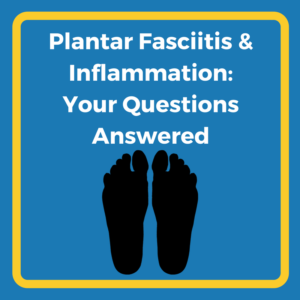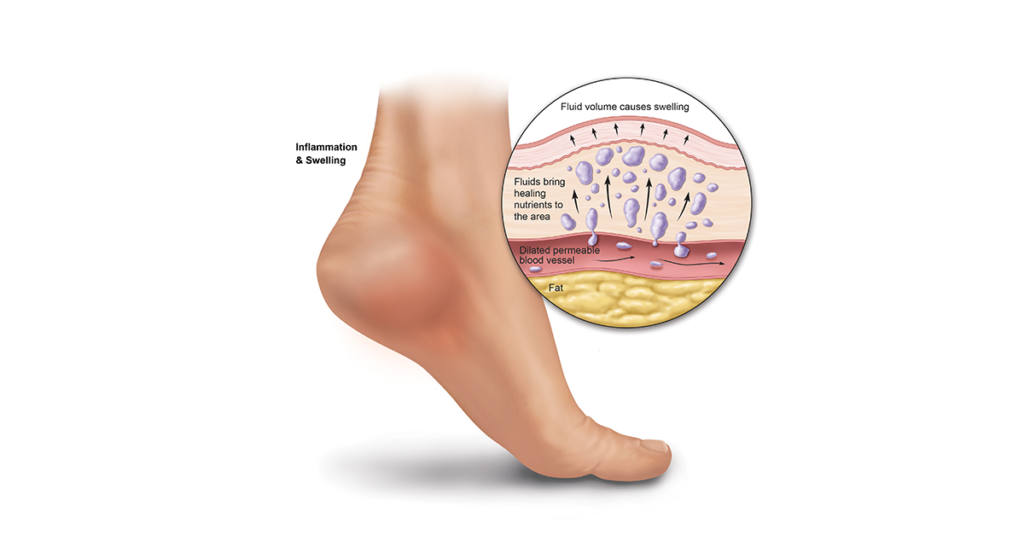 Inflammation and plantar fasciitis go hand in hand, that much is clear. But why? And what can be done about it?
Inflammation and plantar fasciitis go hand in hand, that much is clear. But why? And what can be done about it?
We’ve answered your top questions about plantar fasciitis and inflammation to help you arm yourself with knowledge about one of the most common side effects of this painful condition.
Knowledge is power, and the more you know about the source of your pain, the better you can address–and heal–that pain.
1. Why Does Plantar Fasciitis Cause Inflammation?
To put it simply, plantar fasciitis develops in response to strain and stress on the fascia of your foot–otherwise known as the arch, or the area between your heel and the ball of your foot. When strain or damage from injury or overuse happens, tiny tears appear in the fascia that cause inflammation. As the body attempts to compensate for this damage, small calcium deposits often form that dig into the fatty pad of the heel when you walk–causing further inflammation and pain.

2. How Is Inflammation Identified?
Inflammation typically feels like pain that flares up in the form of swollen tissue, reddened skin, and sometimes heat to the touch. It may feel more difficult to move the inflamed area of the foot. Interestingly enough, inflammation is actually part of your body’s healing response–sending additional blood, hormones, and white blood cells to the injured area of your body for protection and support. It can help to think of inflammation as a signal from your body that something is wrong and needs to be addressed.
3. Can Inflammation Be Present Without Visible Symptoms?
In some cases of chronic, continuous stress and strain to the plantar fascia, it may be possible to ignore or brush off some milder symptoms of inflammation. Pain may not be severe, and redness and swelling may not be apparent to the naked eye at first. Don’t ignore early signs of inflammation like slight swelling and mild pain, before you take action to address the underlying problem.
4. What is the difference between acute and chronic inflammation?
The inflammation you may experience from plantar fasciitis can either be acute or chronic. In other words, the pain you experience long-term as a result of plantar fasciitis is considered chronic, while pain that flares up in the morning when you step out of bed, or when you stay on your feet all day, is acute. Both acute and chronic pain are typically involved with plantar fasciitis, but their treatment should vary.
5. How Can I Treat Acute Inflammation?

Acute inflammation that flares up after a long day on your feet or an injury can be treated with rest, icing, and anti-inflammatory medication like ibuprofen. Make sure to give the injury or the affected area that’s inflamed enough time to heal by staying off your feet as much as possible, and use an ice pack or Ice Slippers consistently over several days.
6. How Can I Treat Chronic Inflammation?
Chronic inflammation should be treated at the source of the problem in addition to using ice, rest, and anti-inflammatory medication for acute symptoms that flare up. Many cases of chronic pain and inflammation of the foot are the result of plantar fasciitis. At the root of the problem is an arch that is injured or strained. By better supporting the arch and positioning the foot so that heel spurs (which can cause inflammation through the simple act of walking as they protrude into the fatty pad of the heel) don’t jut into surrounding tissue, the fascia can begin to heal. Orthotics made especially for heel spurs and plantar fasciitis–not simply cushioning–are the fastest way to heal and support a damaged arch. Incorporating simple stretches to strengthen the arch is also a critical part of healing since a weak arch is much more likely to sustain damage.
When it comes to inflammation, treat the symptoms as they arise, but don’t neglect to treat the underlying problem (typically plantar fasciitis) that is causing the pain and discomfort. Simply treating symptoms is a surefire recipe for a problem that gets worse, and takes longer to treat effectively, as more time goes by. Thankfully, most inflammation resulting from plantar fasciitis can be dealt with simply and effectively at home, using icing, rest, orthotics, and simple stretches.




I’ve been dealing with this fiit over 7 months and am in so much pain ! I work retail so I’m on my feet all day !! I just keep doing the exercises and using ice hoping it will heal !
Hi Vicky, sorry to hear about your heel pain 🙁
Stretching, icing, and resting as much as possible are a great idea. Have you tried our Heel Seats as well? They can definitely make it easier when you work long days. You can learn more about them here: heelthatpain.com/treatments/htp-heel-seats/
Try drinking 8 ounces of real Black Cherry Juice daily. It worked for me. It took me several weeks for me to notice I was walking without having to walk it out. No more pain. Others have noticed the pain relief sooner. It will not hurt you try the Black Cherry Juice.
Hi ive had pf for a year now absolutely awful tried alsorts nothing works got to the end of my tether at the moe taking co codomol nothing else touches it wouldnt wish it on my worst enemy been close to tears some days looks like a trip to the docs even been physio waste of time cant cope much ,onger got insloes do icing stretching hope fully one day will becured cannot wait for that day
Is there a good topical cream to use?? such as biofreeze?
I tried the biofreeze and it did absolutely nothing for me…i am off work for the next few days and the only time i am pain free is when i have my feet soaking in a warm salt bath…i too work retail..
Voltaren gel can help. It is a prescription gel.
I am feeling this pain in the heel for more than a year now.
I’ve been dealing with PF in both feet for almost 2 years! I ice, stretch, rest (as much as possible and have tried various shoes and orthotics. I’ve tried the heal seats and gel heel seats as well. Nothing seems to work for long. I try something new and it seems to ease the pain a bit but that never lasts more that a couple weeks to maybe a month. Standing is the absolute worst. I can walk for a while, but if I have to stand for any length of time my feet are on fire! I even have a bar stool I use in the kitchen to cook and wash dishes. I’m soooo frustrated!
April have you tried an anti-inflammatory diet! And hot heat does wonders for healing
Omg. I got this issue for many years. Doing all what physio advised and had shock wave therapies too. Been using night splint too. Difficult to walk few steps.. Stabbing throbbing pain in bed too. Having difficult nights. Trying deep freeze spray and gel for quick relief. None of the pain killers work.. My GP is not much help either. Walk with walking stick and sometimes use two walking sticks too. Very limited mobility. Please advise what else can be done to ease the pain. Thanks
Do not accept surgery. I had surgery and instead of relief I have a $1100 dollars to pay. the MRI shows that the plantar is very inflamed, the scar tissue is very big and painful, and the pain is worse that before the surgery. I cannot have a normal life. I trusted my doctor who lied and told me that the surgery is easy like a joke.
Try the full insoles from Heel That Pain. They work better for me than the heel seats.
My big toe is inflamed is this normal when you suffer from plantar fasciitis
Hi I have pf and I’m off work with it is it normal to hear cracks and clicking when I move my foot the pain is awful thanks jolene
Has anyone tried the foot massagers…the shiatsu ones that vibrate with heat?
Thinking of getting one…battling with symptoms for a while…
I went via my go to a physio and they gave me shock wave therapy. It worked!! Now I have same problem in other foot so trying to get shock wave again
I Got. Lymphrdema And got plantar fasciitis in my right leg any tips to get rid of it a had plantar fasciitis for 7 weeks now get me down now
I have been suffering with tired aching feet for quite a long time. I went to a Podiatrist and he sent me to a place for insoles. The salesman sent the insoles to the Podiatrist who placed wedges under the heel that are not very thick. Maybe 1/16TH of an inch. This helped for a little while but the tired aching sensation has returned. What do you think could be the problem? Could being 20 pounds overweight contribute to my problem?
Thank you for considering my Problem.
Anonymous
I have been suffering from plantar fascitis for 9 months My GP gave me acroxia pills for almost 3 months causing discomfort to my stomach. Then to physio shock waves once every ,3 weeks . With all this I am still frustrated as I am still in pain.what is your help I have done the rolling exercise and even cold compress. Stretching even. It’s really a depressing condition Can I have any more information
I have been suffering with PF for 2 years. Tried custom orthotics for $250 and they make my feet hurt worse. On my feet 8 hrs at work and can hardly walk at the end of the day. Heel seats help a little and I also use arch supports that I buy at the store. Soak my feet in hot water in the morning and ice at night. Any other advice?